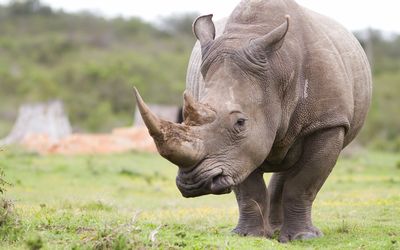Regulate supply chain to protect rhinos
by Alan Collins, Gavin Fraser and Jen Snowball,
2015-12-04 06:03:59.0
CLAIMING that legalising trade in rhino horn is the solution to the problem of poaching is too simplistic. Answers to tricky public policy problems are often never black and white but, rather like rhinos, tend to come in various shades of grey. Simplistic arguments that suggest environmental and social problems can be easily tackled either by state ownership or by unfettered free markets usually tend to be wrong.
Nobel Prize winning economist Elinor Ostrom describes such naïve thinking as the "panacea problem". In essence this means there is not a single policy response that is likely to work. Worldwide legalisation is never going to be a magic wand. Instead there is likely to be a combination of policy interventions which, if implemented together in a rational and coherent manner, can achieve better outcomes in the interests of society and the environmental resource under threat.
We simply do not know what annual demand for rhino horn is, let alone what it might be if trade were legalised. However, there are sound reasons to believe that the demand for horn might be huge and that it would dwarf sales from stockpiles or the biologically feasible level of rhino horn harvesting.
This is because there remains a huge latent demand for rhino horn underpinned by 5,000 plus years of history advocating its use in traditional eastern medicine in China, Thailand, Laos and elsewhere.
Planted false news stories in newspapers and other outlets help sustain the myth that there is a genuine therapeutic benefit from consuming an emulsion of ground horn such that it cures the most serious diseases and ailments. Rising real income growth in these countries has also meant that it is now used by the very rich as a fashionable cure for minor colds and flu.
There is also a market for complete or nearly complete horns (crafted or uncrafted) as valuable "gifts" to influential politicians and business people. These gifts serve as relatively compact stores of asset value in a turbulent world. The holders of such assets would greatly benefit from any path to extinction, as scarcity makes their values soar.
Supplying on a sustained basis the very large amounts of horn needed to meet this demand is also much harder than is claimed. Rhinos are "sensitive souls" and thrive only in geographically extensive bush land. There is mixed evidence about the long-term success of rhino captive breeding programmes.
Moreover, worldwide legalisation would not automatically dismantle the complex illegal criminal supply chains involved in rhino poaching.
Many of these are intertwined with poaching of other endangered species and other criminal activity such as drug trafficking.
The experience of countless criminal mafias operating around the world show us that they do not react passively in the face of other individuals trying to appropriate their lucrative revenue streams.
Instead we could reasonably expect turf wars. Such wars would feature serious sabotage attempts on the legalised supply chains. This would comprise acceleration in the pace of poaching activity.
This presents a perfect storm likely to push critically endangered black rhino to extinction and push SA’s white rhino population to critical endangerment very soon as well.
What then can be done? We suggest that rather than free trade, what is required in such a situation is the skilful development of a well-regulated supply chain focused on rhino horns supplied only from natural mortality and conservation management. In this way revenue from the regulated sale of horns could be recycled to support private and public game reserves, to help sustain rhino populations and cover game reserve costs and good salaries for rangers.
We need to sustain a high price for rhino horn to cover the security costs of combating poaching.
• Collins teaches at the University of Portsmouth and Rhodes University. Fraser and Snowball teach at Rhodes

Picture: THINKSTOCK
CLAIMING that legalising trade in rhino horn is the solution to the problem of poaching is too simplistic. Answers to tricky public policy problems are often never black and white but, rather like rhinos, tend to come in various shades of grey. Simplistic arguments that suggest environmental and social problems can be easily tackled either by state ownership or by unfettered free markets usually tend to be wrong.
Nobel Prize winning economist Elinor Ostrom describes such naïve thinking as the "panacea problem". In essence this means there is not a single policy response that is likely to work. Worldwide legalisation is never going to be a magic wand. Instead there is likely to be a combination of policy interventions which, if implemented together in a rational and coherent manner, can achieve better outcomes in the interests of society and the environmental resource under threat.
We simply do not know what annual demand for rhino horn is, let alone what it might be if trade were legalised. However, there are sound reasons to believe that the demand for horn might be huge and that it would dwarf sales from stockpiles or the biologically feasible level of rhino horn harvesting.
This is because there remains a huge latent demand for rhino horn underpinned by 5,000 plus years of history advocating its use in traditional eastern medicine in China, Thailand, Laos and elsewhere.
Planted false news stories in newspapers and other outlets help sustain the myth that there is a genuine therapeutic benefit from consuming an emulsion of ground horn such that it cures the most serious diseases and ailments. Rising real income growth in these countries has also meant that it is now used by the very rich as a fashionable cure for minor colds and flu.
There is also a market for complete or nearly complete horns (crafted or uncrafted) as valuable "gifts" to influential politicians and business people. These gifts serve as relatively compact stores of asset value in a turbulent world. The holders of such assets would greatly benefit from any path to extinction, as scarcity makes their values soar.
Supplying on a sustained basis the very large amounts of horn needed to meet this demand is also much harder than is claimed. Rhinos are "sensitive souls" and thrive only in geographically extensive bush land. There is mixed evidence about the long-term success of rhino captive breeding programmes.
Moreover, worldwide legalisation would not automatically dismantle the complex illegal criminal supply chains involved in rhino poaching.
Many of these are intertwined with poaching of other endangered species and other criminal activity such as drug trafficking.
The experience of countless criminal mafias operating around the world show us that they do not react passively in the face of other individuals trying to appropriate their lucrative revenue streams.
Instead we could reasonably expect turf wars. Such wars would feature serious sabotage attempts on the legalised supply chains. This would comprise acceleration in the pace of poaching activity.
This presents a perfect storm likely to push critically endangered black rhino to extinction and push SA’s white rhino population to critical endangerment very soon as well.
What then can be done? We suggest that rather than free trade, what is required in such a situation is the skilful development of a well-regulated supply chain focused on rhino horns supplied only from natural mortality and conservation management. In this way revenue from the regulated sale of horns could be recycled to support private and public game reserves, to help sustain rhino populations and cover game reserve costs and good salaries for rangers.
We need to sustain a high price for rhino horn to cover the security costs of combating poaching.
• Collins teaches at the University of Portsmouth and Rhodes University. Fraser and Snowball teach at Rhodes




























Change: 0.11%
Change: 0.16%
Change: -0.42%
Change: 0.35%
Change: -0.54%
Data supplied by Profile Data
Change: 0.00%
Change: 0.00%
Change: 0.11%
Change: 0.00%
Change: 0.00%
Data supplied by Profile Data
Change: -0.06%
Change: 0.00%
Change: -0.03%
Change: 0.07%
Change: -0.11%
Data supplied by Profile Data
Change: 0.00%
Change: 0.00%
Change: 0.00%
Change: 0.00%
Change: 0.00%
Data supplied by Profile Data